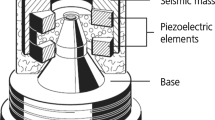Summary
-
1.
The mechanical time resolution is estimated in the ears of noctuid moths (Noctuidae) and locusts (Acrididae). The vibration velocity of small areas on the tympanal membrane is measured by means of laser vibrometry. The impulse response (Figs. 2B and 5 A) and the transfer function (Fig. 3) are obtained directly by stimulation with very short impulse sounds and pure tones, respectively. The transfer function is also calculated from the experimentally determined impulse response, and vice versa. Finally, the impulse response is obtained by calculation from the measured vibrations caused by noise. The directly determined and the calculated transfer functions are rather similar (Fig. 3A-B).
-
2.
The impulse response of the attachment area of the receptor cells in thenoctuid ear is a short, damped vibration with a ‘time constant’ of about 60 μs (Table 1). The attachment area of the receptor cells can thus separate impulses arriving with time intervals larger than 150–200 μs (Fig. 4).
-
3.
The ‘time constant’ of the attachment area of the d-cells in thelocust tympanum is about 90 μs (Table 1). The ‘time constant’ for other parts of the locust tympanum varies between 50 μs and 200 μs (Fig. 6).
Similar content being viewed by others
References
Braun S (1975) The extraction of periodic waveforms by time domain averaging. Acustica 32:69–77
Ghiradella H (1971) Fine structure of the noctuid moth ear. I. The transducer area and connections to the tympanic membrane inFeltia subgothica Haworth. J Morphol 134:21–46
Glaser EM, Ruchkin DS (1976) Principles of neurobiological signal analysis. Academic Press, New York San Francisco London
Gray EG (1960) The fine structure of the insect ear. Philos Trans R Soc Lond [Biol] 243:75–94
Larsen ON (1981) Mechanical time resolution in some insect ears. II. Impulse sound transmission in acoustic tracheal tubes. J Comp Physiol 143:297–304
Michelsen A (1971) The physiology of the locust ear. I–III. Z Vergl Physiol 71:49–128
Michelsen A (1973) The mechanics of the locust ear: An invertebrate frequency analyzer. In: Møller Aa (ed) Basic mechanisms in hearing. Academic Press, New York London, pp 911–931
Michelsen A, Larsen ON (1978) Biophysics of the ensiferan ear. I. Tympanal vibrations in bush-crickets (Tettigoniidae) studied with laser vibrometry. J Comp Physiol 123:193–203
Miller LA (1977) Directional hearing in the locustSchistocerca gregaria Forskål (Acrididae, Orthoptera). J Comp Physiol 119:85–98
Morse PM (1948) Vibration and sound. McGraw-Hill, New York
Randall RB (1977) Frequency analysis. Application Handbook. Brüel and Kjær, Nærum, Denmark.
Roeder KD, Treat AE (1957) Ultrasonic reception by tympanic organ of noctuid moths. J Exp Zool 134:127–157
Skovmand O, Pedersen SB (1978) Tooth impact rate in the song of a shorthorned grasshopper: A parameter carrying specific behavioural information. J Comp Physiol 124:27–36
Varjú D (1977) Systemtheorie für Biologen und Mediziner. Springer, Berlin Heidelberg New York
Author information
Authors and Affiliations
Additional information
We are most grateful to Professor D. Varjú, Dr. S. Boel Pedersen, and Dr. Lee Miller, who critically read earlier versions of the manuscript and offered helpful suggestions, and to the Danish Plant Pathology Institute for supplying the moths. This work was generously supported by the Danish Natural Science Research Council and NATO.
Rights and permissions
About this article
Cite this article
Schiolten, P., Larsen, O.N. & Michelsen, A. Mechanical time resolution in some insect ears. J. Comp. Physiol. 143, 289–295 (1981). https://doi.org/10.1007/BF00611164
Accepted:
Issue Date:
DOI: https://doi.org/10.1007/BF00611164




